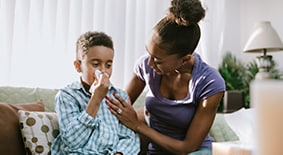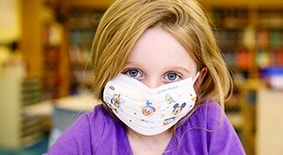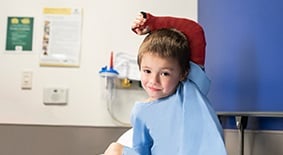Season 1: Episode 5
Hope and Will: A Parenting Podcast from Children's Healthcare of Atlanta
Pediatrician, Urgent Care or Emergency Department: How to Decide When to Go Where
It’s the Murphy’s Law of parenting: Anything that can go wrong, will go wrong outside of normal business hours. When your child has an injury or illness, it’s easy to go straight to panic mode. Can it wait until your pediatrician is available, or is it time to head to an urgent care center or a hospital’s emergency department?
Dr. Mark Griffiths, a pediatric emergency medicine physician, and Monique Keeton-Perkins, a clinical educator with more than 10 years of experience as an urgent care nurse, join Lynn for an insightful chat that could save you precious time—and help you keep your cool—when deciding where to go. Together, they weigh in on common questions like, "When does a fever warrant a trip to the ER?," "How do I know when a respiratory illness needs medical attention?" and "Can urgent care treat a kid who swallowed a battery?”
With expert insight into what it’s like on the other side of those waiting room doors, this is a conversation you don’t want to miss.

Dr. Mark Griffiths, Pediatric Emergency Medicine Physician
Mark Griffiths, MD, serves as Medical Director for the Emergency Department at Children’s at Hughes Spalding and is an Assistant Professor of Pediatric Emergency Medicine for the Emory University School of Medicine. He’s also Dad to four kids, ranging in age from 5 to 13.
Read My Bio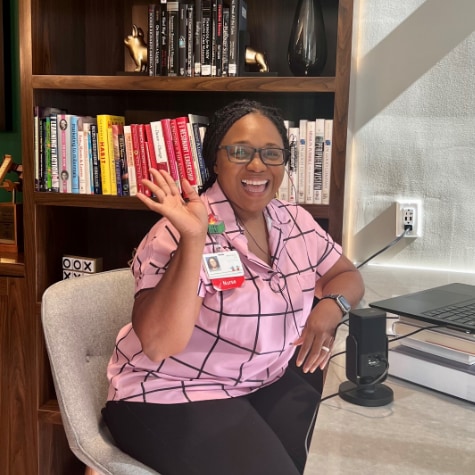
Monique Keeton-Perkins, RN, Clinical Educator and Urgent Care Nurse
With more than 12 years of experience in urgent care, Monique Keeton-Perkins has worked hundreds of shifts as a triage or “screening” nurse. She offers a wealth of insight into what it’s like beyond the waiting room door—not to mention loads of empathy as Mom to three kids.

Lynn Smith
Lynn Smith is a veteran journalist, podcast host and mom of two boys. Her experience as the parent of a patient at Children’s inspired her to advocate for spreading awareness of childhood illnesses and injuries.
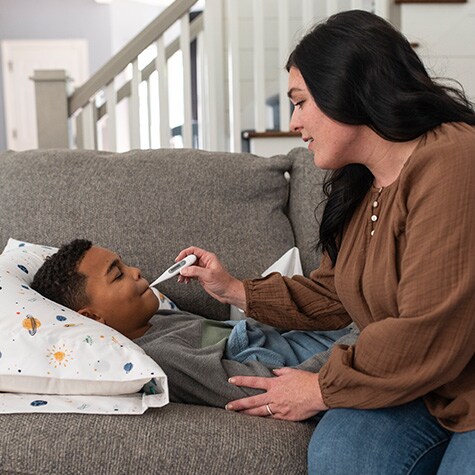
Where to go when your child is sick
If your child is sick or injured, it is important to know where to take them for care. Learn what can be treated at a pediatric urgent care center and a pediatrician's office.
Learn More
Lynn: As parents, we have all been there. Whether it's a persistent fever, rapid breathing, maybe a bad spill off a bike or a deep cut that might require stitches, it's that moment that you realize your child needs medical help. It can leave us all feeling panicked.
If your pediatrician is unavailable, should you head to an urgent care or go straight to an emergency department? Dr. Mark Griffiths , a pediatric emergency medicine physician and medical director for the emergency department at Children’s Hughes Spalding Hospital , and Monique Keaton Perkins, clinical educator with more than 10 years of experience as an urgent care nurse, join us.
They share what they want every parent to know. Should you find yourself in need of pediatric care, their insight could help you more confidently get child the care they need.
Lynn: Dr. Griffiths, thank you so much for being with us. I want to get to know you and your role in the emergency department.
Dr. Griffiths: I'm a pediatric emergency medicine physician and the medical director of the Children's Healthcare of Atlanta Emergency Department at Hughes Spalding. I am also an assistant professor for the Department of Pediatrics at Emory University School of Medicine.
Lynn: Dr. Griffiths, can you paint a picture of the behind the scenes when it comes to the emergency department?
Dr. Griffiths: Emergency medicine is interesting in that you never know what your day is going to be like, and there unfortunately isn't a typical day for us.
Some days, we see children with respiratory illnesses. Other days, we reduce or fix bones in kids that have gotten injured on the field of play, and we diagnose children with cancer. We give good news to parents that their child’s blood tests were normal, and it was a simple viral illness that the child should get over.
Our clinical staff goes through these wild range of emotions on a day-to-day basis. One of our biggest struggles is being able to compartmentalize and give each family the dedicated care that they deserve and that we want to give.
I was at a conference last week in Seattle with a bunch of pediatric emergency medicine researchers from all over the country. And every pediatric hospital from Seattle to New York and everywhere in between is struggling with high levels of respiratory illnesses. The example I've been giving families is that when COVID-19 first emerged, it was the ultimate bully.
It bullied us and it bullied other viruses. For a year and a half, we did not see many other respiratory illnesses. because everybody was wearing their masks and sanitizing like crazy. Everybody was keeping six feet apart. During COVID-19, kids just didn't exchange the viruses like they normally do.
As we’ve gotten more comfortable and people have gotten vaccinated, we've relaxed some of the restrictions that we had initially. We’ve seen all these viruses come back and usually they would come in very predictable patterns. But now they've all come back together. I had a child last week who had 10 days of fever straight.
When we tested them for a viral illness because they got admitted and they were having some breathing difficulties, they tested positive for four different viruses all at once. That's just what we're seeing right now. Everybody's coming in with everything loaded on.
Lynn: This episode is important because it provides people the information on when they need to act. We’re going to go through a lot of different scenarios throughout this episode. But first, outside of the emergency department, you are a dad. You have four children yourself. I'm sure you have plenty of experiences of that feeling as a parent of, “What do I?”
Dr. Griffiths: I get those opportunities often because my kids are very active. I try to keep them involved in sports so there's risk of sports injuries. Then I get the privilege also of having a very large family.
Everybody calls me at all hours of the day because everybody's all over the country and you have to make those decisions in the middle of the night sometimes. But I enjoy it. I mean, this is why I went to medical school to be a resource to my family and to my community.
Lynn: Your family's lucky because they can just pick up the phone. I can give a personal scenario. It's the middle of the night, my child has a fever, it seems like they are struggling to breathe. Do I take them to the ED? Or do I wait to go to the pediatrician in the morning?
With my 7-week-old son, we were on the phone with our pediatrician at 10 p.m. the night before Christmas Eve. He had runny nose and he seemed to be coughing a lot, but a different kind of cough than I've ever heard. They said, “You could go either way. You can go to the emergency department if you want but it's Christmas Eve tomorrow, so it could be a long wait. Or maybe just wait it out and come to us in the morning. We went in the morning and our pediatrician was said, “Get to the ED.” We went and we were admitted into Children's for RSV. He was in there for 10 days and it's one of the reasons we are dedicated to Children’s.
You saved him because of that fast action by taking him right away and admitting him in that moment. As a parent, what are some of the key things we need to be thinking about when making that decision?
Dr. Griffiths: I like the steps that you took. I think you did exactly what I would encourage anybody to do that called me. I'm always reminded of advice I got from one of my seniors when I was a freshman back in college. The smartest kids don't necessarily know all the details, but they know how to get to the right resources, and they activate those rights.
Parents, the best tool in the tool belt is your pediatrician. That's the person that knows your child best outside of the family. They can kind of pick up on subtle things like, “That child is not acting like they normally do. They're not as active as they usually are, or they're not breathing as comfortably as I've grown accustomed to seeing them breathe.”
I think using that pediatrician as your quarterback is the best first move, and then based on their discretion, then utilizing some of the other tools that might be available in your local community. In our area, we are very fortunate to have a robust urgent care system. I look at that as the next level of protection for our kids because there are pediatricians who can give that level of expertise in terms of diagnosis and treatment that are available after hours.
Pediatricians are human too, so they've got to close the doors. Sometimes we've got the urgent care centers as that cocoon outside of those normal hours, and they can handle severe cases. At the emergency department, we've got 24/7 coverage. We've got all the specialists you can think of, and we've got the intensive care units for the sickest children. It’s important to utilize our resources in a sequential manner so that we don't exhaust them.
Lynn: Emergency rooms are notorious for long waits, but how do you ensure that people that need immediate attention are being tended to first? That's a juggling act I can imagine for you.
Dr. Griffiths: It is, and unfortunately, it's not one that we can predict with a 100% accuracy. The month before COVID-19, we were going through a flu surge, and we were pulling physicians from everywhere. I had everybody working in the emergency department just trying to staff some of these clinical needs that we had.
When COVID-19 hit, we went from seeing 200 patients a day to 50 patients. When you've got this variability, it becomes difficult to staff the emergency department, but we do our best we can. At our hospital, we look back at previous years to kind of predict down to the day what that volume is going to be.
That's how specific we try to be so we can staff accordingly. We prioritize those that are sickest. If a trauma comes in, sometimes we'll get as much as 15 minutes head time or leeway before the trauma arrives to as little as 30 seconds.
Those are our highest priority. We also have things like children that might be having breathing difficulties from near drowning incidents, respiratory illnesses, or overwhelming infections like sepsis.
If the highest priority group comes in in significant numbers, then the less severe patients, or lower acuity, have to wait.
Sometimes it's hard for folks to understand because if you've been there for 2 or 3 hours, and then somebody that just got there 15 minutes ago is getting all this attention, it's difficult to process that. But I try to encourage folks by saying, “Do a simulation in your mind as if it was your child, what would you want us to do?” I think when people start to think of it from that standpoint, the paradigm shifts.
Lynn: I have two boys, so I've been to the emergency department at Children's Healthcare Atlanta more times than I can count. In times where it wasn't serious, I knew it was okay because there's somebody else's child that needed immediate attention. Are there certain times or days that you notice an influx of patients?
Dr. Griffiths: I think all emergency departments know that Mondays are the busiest day. You get those illnesses you try to power through over the weekend and then just can't do it. We see a flux in the beginning of the week, but then also toward the end of the week before resources start to shut down. On the weekends, we see a lot of sports injuries.
Lynn: When we did our drowning episode, the doctor was mentioning that emergency departments see increased cases of drowning during Labor Day weekend.
That's your reality and it's amazing that you can continue to be such an incredible lifesaving resource for people in all these different scenarios. Let’s talk about the child with the fever for 10 days. What’s some care that goes into taking care of that child, and when do you know to go to urgent care or the emergency department?
Dr. Griffiths: As you are growing up, your body goes through significant changes and one of those changes is your immune capacity. The way we approach a fever is different in a 5-year-old compared to a 5-day-old. If you're a 5-year-old, your immune system is fully developed. You're probably up to date on your vaccinations. You might have even gotten your COVID shot, and so I don't worry as much.
If you contrast that with a 5-day-old whose immune system is very immature, and they are relying on a lot of the mom's antibodies that's transmitted through the breast milk and leftover from the intrauterine phase, then there’s a potential for them to get very sick very quickly. That can happen to the youngest of children—I've even diagnosed a urinary tract infection in a 3-day-old girl.
Lynn: Let's talk about something like a suspected broken bone. What kind of care would you look toward?
Dr. Griffiths: When a child has a broken bone, sometimes their immediate reaction is to cry. But I always tell them, “I don't know if you realize this, but you're a superhero because if I break my bone, I have to get surgery because my bones are done growing.” They're not going to fall back in line like they should, but children, because they're still growing, still maturing. If the bones are lined up, then the bone is going to heal well. It’s still best to get those kinds of injuries evaluated in the emergency department.
Lynn: That's why this is so helpful because these are scenarios that I wouldn't have thought about. Let’s talk about something like a persistent, productive cough. Dr. Griffiths: When it comes to respiratory illnesses, we are particularly careful with children because their ability to breathe isn’t as high as it is it in adults. You want to look at the child and see if they are breathing heavier than they normally do. If they can blow their nose, they may be able to clear some of the mucus out. If they are younger and unable to blow their nose, I recommend using a device called the Nose Frida.
It works well. If you can see how well they're breathing, and if they're breathing okay to you, then I think it's safe to follow up with the pediatrician and get an outpatient assessment. If you notice that their belly is moving harder than it normally does or if you start seeing the skin around the ribcage suck in, and this little notch at the bottom of their neck called the super sternal area, starts to suck in, then I think you need to go see a higher level of care, either the urgent care or emergency department.
Lynn: Can we talk about something like vomiting and diarrhea? We have this with kids all the time because of the stomach bug. How do you know when it's something more serious that you can't just treat at home?
Dr. Griffiths: I would say because of technology and medical advancement, we have more options now than we did in the past. Previously, if you had the vomiting and diarrhea was probably due to a virus, then the risk was you could get dehydrated and need fluids. With some of the oral medicines we have now, we can suppress the desire to vomit, then our patients can stay hydrated at home and avoid having to come for an IV.
Lynn: What about something like a suspected or accidental swallowing of potential toxin?
Dr. Griffiths: When it comes to substances, we have resources, not only in your pediatrician, but in poison control. The control number is standard around the country and folks can call that number and get some good advice from a medical toxicologist. That way you potentially stave off a trip to the emergency department if they deem it as something that's not toxic.
Lynn: Let's talk about head injury. This is very common, especially with high school football players, but this sadly just happened to us yesterday. My 3-year-old son is in preschool and we got a call. The two children were running at each other, and they hit each other right in the head. He had a huge goose egg in the middle of his head and it was starting to turn blue. I wanted to take him to be examined but my husband said, “Let’s just wait it out.” I slept with my son all night. I was panicked that he was going to start throwing up from a concussion and I didn’t know what to do. How do you know what to do in those types of situations?
Dr. Griffiths: I think concussions is one of our top five diagnoses that we see in the pediatric emergency department, and fortunately, we have some good research on which kids need that higher level of care versus which ones don't.
When I was a resident, we were participating in this research study called the PECARN (the Pediatric Emergency Care Applied Research Network) Head Injury Study. It's this collective of pediatric emergency physicians all around the country that come together to do studies together rather than just in single units around the country.
A typical study will give you a few hundred participants. I believe this one had about 68,000 participants. We had really good information and we know from the study that children do well with head injuries. They just bounce back well. But when it comes to head injuries, the best person to make that determination is the parents. Trust intuition and go to the emergency department because like respiratory illnesses, any kind of injuries to the head or to the eyes need to be taken seriously. We want those injuries to be evaluated by the people that have the most resources.
Lynn: What are some of the types of accidents or injuries you're seeing so regularly that parents could act right now to prevent them from happening?
Dr. Griffiths: I think your last example was perfect. The head injury is No. 1, and unfortunately, it's one of the most preventable injuries because we have good technology. We've also got good helmets, so bicycle, skateboard, and roller skate safety are important.
Lynn: I'm curious about when it comes to a severe cut that might need stitches. How do you know when it's serious enough?
Dr. Griffiths: That’s also a great one where you can talk to the pediatrician or seek care in urgent care first because they can visually see the injury for themselves and give you an objective assessment. With a cut, they can see if it’s something that needs to be repaired or not.
Lynn: You make such a good point that so many of these scenarios are based on going off intuition. What's the one piece of advice you would leave with parents if their gut's telling them their child needs to be seen?
Dr. Griffiths: That's a good question. I would say to engage your resources like your pediatrician and then have a narrative to share with them.
Lynn: I can tell you that as parents, we are forever grateful for people like you, Dr. Griffiths.
Now we're going to switch gears, moving out of the emergency department and into the urgent care setting. We are getting some behind the scenes insight from Monique, a nurse who spent more than a decade in urgent care, often working as the triage or screening nurse who helps assess patients to determine how quickly they need to be seen. Or in some cases, arranging transport if the patient needs to go to the emergency department.
Monique, can you give us an idea of what a typical day is like for you and your colleagues?
Monique: We see kids with ear pain, sore throat, and respiratory distress on a regular basis. Our volumes have really increased at our site recently. We have 46 patients within the first hour, which can be a heavy load on not only the patient's families that are waiting, but on the providers and the nurses as well. We are quickly trying to get those patients assessed appropriately and get them back to see them.
Lynn: What about a scenario that is more serious? Something like swallowing either a toy, coin or battery. Can you tell us in a situation like that, how would everything go down?
Monique: So those patients should go straight to the emergency room. Those are very severe situations to where we at urgent care, are not capable of handling the care for that patient. Parents need to get them quickly to the emergency room, whether it's the parent driving the child or calling 9-1-1. We are very limited in our resources at urgent care, so the emergency room will be the proper place to take them because they're going to have the required patient care that the child needs there.
Lynn: So, the difference between the emergency department and urgent care is just the ability and available equipment?
Monique: That is correct. We do have a lab, but we are limited to the type of tests that we can run in the urgent care lab. In the hospital setting, the emergency department has a lab that can run tests and get those results to you and the provider quickly versus having to send the lab out to get results elsewhere.
We do have x-ray. When a kid comes in for a head injury, we don't have the capability of doing a CT scan. We don't have the capability of doing MRIs or ultrasounds for when the kid comes in with testicular pain. That's why those things should be going to the emergency department. Your child may surgery to correct testicular pain. For sickle cell patients, we can do labs, but we don't have the hematologist there to consult right away. That's why it's very important that patients with those chronic conditions to go to the emergency room with complaints so they can get the care that they need.
Parents should bring the children to urgent care during the hours that is the pediatrician’s office is closed, during holidays or on the weekends when you can't get them. We would like patients to first start there because again, we want that continuum of care with their pediatrician. Kids that are in respiratory distress that may have a history of asthma and have filled completed treatment at home—those are things that should go directly to the emergency department. If you are concerned that your child is dehydrated, that’s the emergency department because we don’t provide rehydration fluids.
If your child's vomited twice a day, but they've been able to hold down food, those are things that you can see your pediatrician for the next day.
Lynn: What are some of the biggest changes that you've seen in the patients that are coming through urgent care?
Monique: The severe illness that they are experiencing when they come into urgent care. One of the biggest things that I think that we see on a constant basis are the asthmatic patients that are coming in where they may have received three treatments at home in the last four to six hours, and they’re just not improving. Parents should be taking them to the emergency department because they have failed treatment at home and the child needs to get proper care.
It used to be in urgent care, we saw more of the simplistic illnesses like ear infections, rashes, common colds, sore throat, pink eye. We still see those things, but we see more severe illnesses and chronic conditions such as sickle cell patients in the urgent care that should be going to the emergency department.
Lynn: What are some other scenarios that you can point out specifically that you would feel comfortable seeing there in the urgent care so that there's not as much of a load on the ED?
Monique: Sore throats, ear pain, allergies, cold symptoms, minor injuries and sports injuries are things that should be coming to the urgent care because we can see those. We can stabilize injuries and put splits on them, and then have them to follow up with orthopedics if needed. For minor lacerations, if there is no continuous bleeding, they are small or don’t appear to be extremely deep, we can care for those in urgent care. Those are things that we can care for in the urgent care. However, on the screening nurse will take a quick look at the laceration to determine if it’s something that can be treated at urgent care of if the child needs to go to the emergency department.
Lynn: Do you think patient volumes at urgent care are worse post COVID?
Monique: I think we have a new norm. It used to be that we had respiratory season which was early fall to late winter, but now, I think respiratory season is year-round. In the summer, our volumes typically dipped, but not the last two summers. Our volumes have stayed high consistently. I think after COVID, there's just been a new normal of high viruses.
Lynn: What are some of the things you do to reassure parents and children because this is a scary time when they're walking through those doors?
Monique: I think for parents, just reassuring them regarding their concerns, listening to them and answering their questions, For the kids, it’s making it a fun time for them—not making it scary. We give out stickers or we play games. We do anything to make them comfortable. Just the simple things of letting them sit in their parents' laps while you're doing their vital signs.
Those things are comforting, not removing the parent from the room while you're doing anything with the child because they play an important role in the security of their child. Letting them be involved as much as possible when it comes to their child’s visit makes a difference in how we care and treat for our patients.
Lynn: Do you have any advice for parents in keeping calm?
Monique: We’ve had some emergencies where parents are very upset because they don't know what's going on. We take that moment to pull the parent aside, and explain to them that they need to remain as calm as possible.
Take some deep breaths because your child can feel that you are afraid, and so they're going to be afraid too. It’s important to also explain every step to the parent to give them a sense of security. Keeping them involved in what's going on is a great tool for creating that partnership between the provider, the caregivers, and the parents.
Not all parents are familiar with urgent care. This may be their first visit, so explaining when they sign in after they're registered. “There are three patients ahead of you before you will see the screening nurse.” Then after the screening nurse sees them, “There's so many patients ahead of you before you're going to see the provider.” Informing and communicating to the parent at every step of the way makes for a great visit and a great understanding of what is going on during that time.
Lynn: What's the one thing that you would want to tell parents when they are visiting an urgent care center?
Monique: Every parent feels that at that moment that their child concern or sickness is the most important. At that moment, we are doing our best to recognize those kids that need to be seen right away. The same providers and nurses that are caring for the sickest patient are also caring for your child that may not be as severe of an illness as the other. Please be patient with us. We are trying our best to provide safe quality care to all patients that walk into our facility.
Lynn: I want to thank Dr. Griffiths and Monique for joining me today. I also want to give thanks to them and their colleagues who work tirelessly to keep their doors open and be at the ready whenever our kids need them. As we continue to see a surge in respiratory illnesses, doctors tell us there are three things you can do to help them: get those vaccinations, flu and COVID; stay home if you’re sick; and wash your hands thoroughly.
This podcast is for general informational and educational purposes only. It is not to be considered medical advice for any particular patient. Clinicians must rely on their own informed clinical judgements when making recommendations for their patients. Patients in need of medical or behavioral advice should consult their family healthcare providers.
